
Live Reviews: Dublin Electronic Arts Festival
Electronic noise: either you view it as an irritating addendum to the intended functions of analogue technologies, or you take your lead from today’s sound artists and technophiles and celebrate it as equal parts artistic resource and sentimental curiosity.
Does radio static simply connote signal interference or the altogether more biblical echo of the Big Bang still reverberating through the universe after fifteen billion years? As digital technologies supplant their analogue forebears in all things audio, the wrinkles that digitisation have smoothed out have become increasingly fetishised.
Beauty, it seems, lay in these cracks. Analogue technologies found themselves front and centre at many of the events at the fringe of this year’s Dublin Electronic Arts Festival, either as subjects for nostalgia-tinged lectures and films, or as performance tools.
i-and-e, the nom de guerre of Dublin-based improv duo Paul Vogel and David Lacey, hosted German musician Annette Krebs, who employed both analogue and digital technologies in performance at the Irish Institute on Pearse Street. Lacey and Vogel, whose recent release, The British Isles, an album inspired by mid-twentieth century British film-makers such as Humphrey Jennings and the duo Michael Powell and Emeric Pressburger, explores the ambiguity between performance, environment and reproduction. The pair are responsible for much of the more adventurous improvised music programming that takes place in Dublin. Krebs, who combines prepared guitar with radio, tapes, mixing desk and laptop, epitomises the ascetic approach to group interaction taken by i-and-e, which demands that the musicians carefully weigh each impulse against the prevailing parsimony of the music. The resulting frugal aesthetic ensures that each utterance has an import that more eventful textures would not permit. The pressure and angle of a bow against a cymbal is thrown into stark relief when set against such a spare backdrop. Consequently the available vocabulary of each performer grows exponentially. These musicians are forever eloquent practitioners of this expanded lexicon.
The Joy Gallery on Rutland Place was the venue for more improvised music on Saturday evening. I had hoped to see the Electronic Sensoria Band with Itaru Oki, but, due to delays, I could only stay to watch the first act, Safe, which nevertheless provided an interesting counterweight to the previous evening’s taciturn improvisations. The trio flooded the space with a more cacophonous offering than was on show the night before. Rather like a large Rothko canvas, the music dominated the room from the start with a voluble and unrelenting monochromatic texture. Just like Rothko’s paintings, this apparent homogeneity disguised a deep well of contrasting shades that pulsed and throbbed in close proximity to each other.
In keeping with the improvised music theme, the Improvised Music Company staged a performance at J.J. Smyth’s with members of Dublin’s Bottlenote Music collective. Many of Dublin’s young jazz musicians are venturing well beyond the conventional rhythmic and harmonic boundaries of jazz and finding inspiration in a more abstract language. Occasionally sounding like a flight control module from the television series Blake 7, this music was more sporadic and less practised than Friday and Saturday’s concerts, but nonetheless intriguing for what it may yet unearth. Justin Carroll’s judicious use of Fender Rhodes and a ring modulator illustrated why further concerts of this nature should be encouraged by the IMC.
Published on 1 January 2009
Rob Casey is a Dublin-based musician and composer of electronic and acoustic music.










